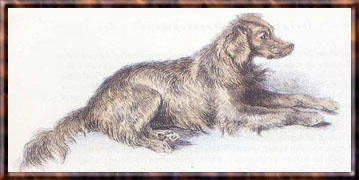|
|
|
Appearance of setters in Ireland can be traced back to the 1700s. It is characteristic of almost all setters, when focusing on something, they shift their weight to their backside as their body becomes flat approaching the ground, while keeping up one of their front legs, as they smell into the air with their nose kept high. The dog seems to be sitting, hence the origin of the name 'setter'.
A well-known
example
of the Setters is the Irish Setter. How did this beautiful, elegant,
dark red breed look at the beginning? Well, painters of the first
pictures depicted a yellowish-red dog which resembled to a longhaired
Vizsla. Intentional,
gradual
breeding conception, however, changed
the colour to bronzish brown,
mahogany. One of the first examples that looked very similar to today's
Irish Setters, was Kuno v. Habichtshof with a sensational coat, colour
and body. Popularity of the Red Irish Setter increased with the
appearance of one of the first well-known stud dogs: "Champion
Palmerston". The "Red Irish Setter Club" was founded in 1882, when it
was also declared that the Irish Setter was to be red. The 1890s brought
a significant change as how the type was viewed: the breed became a
popular show dog and less and less people used them for hunting. During
this period the type was taken to America where it became very popular
and more and more people started to breed it. The Irish Setter is one of
the most beautiful, elegant breeds which conquered the whole world not
only with its impressive looks but with its nice charming character. |
